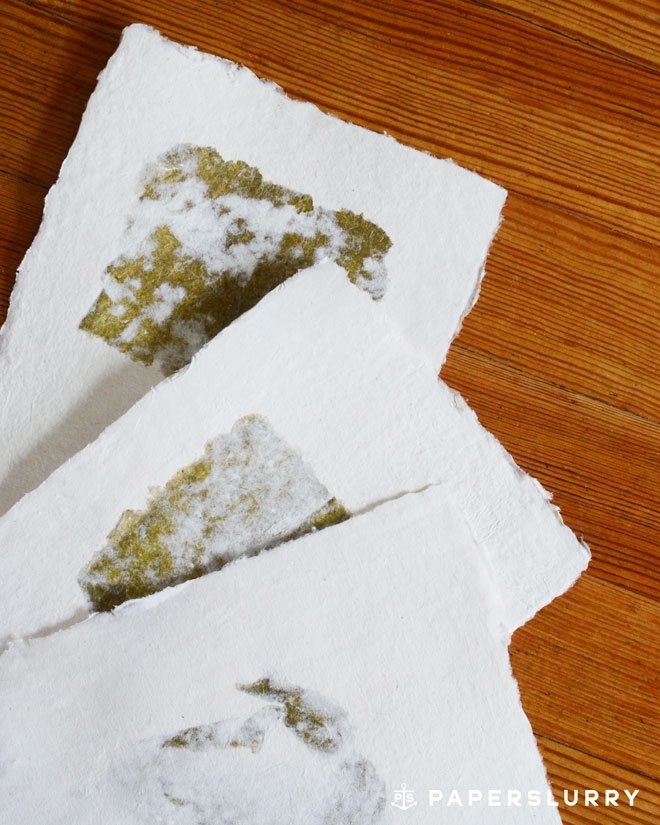Creative Papermaking Techniques Using a Deckle Box (Part 3)
Handmade paper grants a particular kind of creative freedom for the artist—by creating your own sheets of paper, you’re able to go beyond the surface of paper as a substrate and create unique works made completely of handmade papers. These unique sheets might serve as the basis for other works on paper, or become art works all on their own.
Once you’ve made a deckle box and mastered the basic technique, you’re ready to embark on a project that incorporates your new equipment. You’re in luck, we have artistic ideas on how to use that trusty deckle box. With a few types of pulp and some inclusion materials, you’re well on your way to creating a new series of work!
When using a traditional mould and deckle, the goal is often to create an evenly formed sheet of paper that is identical to the others pulled from that vat. Deckle boxes can be used to create specific weights of paper, since the pulp and water can be exactly measured before adding to the box.However, deckle boxes can also be used to create a sense of movement and transition, while maintaining the cohesive qualities of a single sheet of paper. Since the fiber is contained within the boundaries of the deckle box, you are able to experiment with a variety of inclusions and combinations without affecting an entire vat of fiber.
Including Materials for a Series
Creative hand papermaking techniques with a deckle box, handmade paper
Creative hand papermaking techniques with a deckle box, handmade paper
While you can also add inclusions by layering materials between multiple sheets, placing them in the deckle box positions them in an organic matter, arranged by the unique vatman’s shake. The imagery may vary from piece to piece, but including the same material in each sheet of paper unifies the work.
While you might choose to incorporate finer materials throughout the entire sheet, another idea is to pick a larger material, like a scrap from a drawing or another sheet of paper, and see how it moves around the sheet by using the deckle box.
THE TECHNIQUE:
Set up your vat and deckle box, using the instructions provided here. Simply float in your inclusion, experimenting with how the pulp surrounds, reveals, or obscures your image or object. Pull the sheet and adjust the shake to arrange the inclusion. If you’re happy with your sheet, be sure to take note of how much water and fiber you’d added into the deckle box so you can duplicate the process. You might aim to have your inclusion appear in the same place on each sheet, but you might also choose to incorporate the differing arrangement of the inclusion as another conceptual level to your work. The repetition of this form can unify a series of works.
USING YOUR PAPER FOR PROJECTS
Papers formed this way could also be incorporated into book arts project that shifts a recurring image over the pages. An accordion book construction method would work particularly well with this technique. Deckle box sheets also work beautifully as soft covers for book arts projects.
Blended Pulps for Single Sheet Works
Fibers of different structures will combine in unique ways across your sheet. Some papermaking materials have longer fibers (like kozo) while others are shorter (like cotton linters). When you combine these materials in the deckle box, their different weights and structures will cause them to interact in interesting ways across your sheet.
Perhaps you pigment several types of fiber the same shade, which will add interesting but subtle textural shifts across your sheet. Experiment with changing these variables to create your blended single sheet works.
THE TECHNIQUE
Once you’ve established how thick your sheets need to be, you can become creative in how you vary the pulp by adjusting your shake. Putting two different colors of pulp, or pulps that have been beaten to varying degrees, will begin to blend together depending on how vigorously you shake. The more aggressive the shake, the more blended the fibers will become. Water levels also will affect your shake time—less water means faster draining time and less ability to rearrange the fibers.
Experiment with how you place the pulp and the different ways you pull the sheet (remember, there are two ways to use the deckle box). If you aren’t satisfied with the sheet, go ahead and save the pulp. These fiber blends are a great way to introduce yet another type of pulp into your deckle box, that will match the original color palette.
USING YOUR PAPER FOR PROJECTS
These blended paper sheets are a compelling base for print works or collage pieces. The paper, when formed in this manner, is not so much a background but a thoughtfully constructed layer of your work. The deckle box sheets can also be used if you’re editioning art work. While the earlier technique embraced the varied placement of inclusions, a deckle box can also be used to create more consistent sheets. When using the deckle box for editioning, take note of how much strained fiber you’re adding to the vat each time to insure that sheets will weigh the same.
COMBINING WITH OTHER CREATIVE PAPERMAKING TECHNIQUES
Both of these techniques could be combined with multiple couching to further build layers. Pulp painting or pulp printing are additional ways to incorporate imagery into these handmade paper art works while still only using paper pulp!
Comment down below and share with us how you’ve used deckle boxes to expand your creative process, we’d love to know!
MORE ON DECKLE BOXES:
Check out this video of Artist Firelei Báez using “the magicians trick” in the production of her edition at Dieu Donne
Artist John Kessler uses the deckle box technique to facilitate his multi-media approach to handmade paper at Pace Paper here
Article by Katharine DeLamater
Project photos by May Babcock






